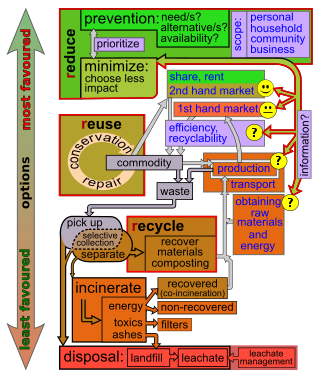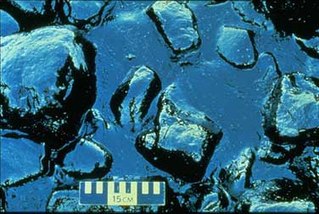Related Research Articles

The Environmental Protection Agency (EPA) is an independent agency of the United States government tasked with environmental protection matters. President Richard Nixon proposed the establishment of EPA on July 9, 1970; it began operation on December 2, 1970, after Nixon signed an executive order. The order establishing the EPA was ratified by committee hearings in the House and Senate.

Industrial waste is the waste produced by industrial activity which includes any material that is rendered useless during a manufacturing process such as that of factories, mills, and mining operations. Types of industrial waste include dirt and gravel, masonry and concrete, scrap metal, oil, solvents, chemicals, scrap lumber, even vegetable matter from restaurants. Industrial waste may be solid, semi-solid or liquid in form. It may be hazardous waste or non-hazardous waste. Industrial waste may pollute the nearby soil or adjacent water bodies, and can contaminate groundwater, lakes, streams, rivers or coastal waters. Industrial waste is often mixed into municipal waste, making accurate assessments difficult. An estimate for the US goes as high as 7.6 billion tons of industrial waste produced annually, as of 2017. Most countries have enacted legislation to deal with the problem of industrial waste, but strictness and compliance regimes vary. Enforcement is always an issue.
Green chemistry, similar to sustainable chemistry or circular chemistry, is an area of chemistry and chemical engineering focused on the design of products and processes that minimize or eliminate the use and generation of hazardous substances. While environmental chemistry focuses on the effects of polluting chemicals on nature, green chemistry focuses on the environmental impact of chemistry, including lowering consumption of nonrenewable resources and technological approaches for preventing pollution.

Waste (management) hierarchy is a tool used in the evaluation of processes that protect the environment alongside resource and energy consumption from most favourable to least favourable actions. The hierarchy establishes preferred program priorities based on sustainability. To be sustainable, waste management cannot be solved only with technical end-of-pipe solutions and an integrated approach is necessary.

Pollution prevention (P2) is a strategy for reducing the amount of waste created and released into the environment, particularly by industrial facilities, agriculture, or consumers. Many large corporations view P2 as a method of improving the efficiency and profitability of production processes through waste reduction and technology advancements. Legislative bodies have enacted P2 measures, such as the Pollution Prevention Act of 1990 and the Clean Air Act Amendments of 1990 in the United States Congress.

The Ministry of Environment is the South Korea branch of government charged with environmental protection. In addition to enforcing regulations and sponsoring ecological research, the Ministry manages the national parks of South Korea. Its headquarters is in Sejong City.
Cleaner production is a preventive, company-specific environmental protection initiative. It is intended to minimize waste and emissions and maximize product output. By analysing the flow of materials and energy in a company, one tries to identify options to minimize waste and emissions out of industrial processes through source reduction strategies. Improvements of organisation and technology help to reduce or suggest better choices in use of materials and energy, and to avoid waste, waste water generation, and gaseous emissions, and also waste heat and noise.
Design for the environment (DfE) is a design approach to reduce the overall human health and environmental impact of a product, process or service, where impacts are considered across its life cycle. Different software tools have been developed to assist designers in finding optimized products or processes/services. DfE is also the original name of a United States Environmental Protection Agency (EPA) program, created in 1992, that works to prevent pollution, and the risk pollution presents to humans and the environment. The program provides information regarding safer chemical formulations for cleaning and other products. EPA renamed its program "Safer Choice" in 2015.
The Massachusetts Toxics Use Reduction Institute (TURI) is a state agency of the Commonwealth of Massachusetts. It was established in 1989 when the Toxics Use Reduction Act was passed by the legislature. TURI is located at the University of Massachusetts Lowell in Lowell, MA.
Title 40 is a part of the United States Code of Federal Regulations. Title 40 arranges mainly environmental regulations that were promulgated by the US Environmental Protection Agency (EPA), based on the provisions of United States laws. Parts of the regulation may be updated annually on July 1.
Source reduction is activities designed to reduce the volume, mass, or toxicity of products throughout the life cycle. It includes the design and manufacture, use, and disposal of products with minimum toxic content, minimum volume of material, and/or a longer useful life.

The Clean Air Act (CAA) is the United States' primary federal air quality law, intended to reduce and control air pollution nationwide. Initially enacted in 1963 and amended many times since, it is one of the United States' first and most influential modern environmental laws.
To protect the environment from the adverse effects of pollution, many nations worldwide have enacted legislation to regulate various types of pollution as well as to mitigate the adverse effects of pollution. At the local level, regulation usually is supervised by environmental agencies or the broader public health system. Different jurisdictions often have different levels regulation and policy choices about pollution. Historically, polluters will lobby governments in less economically developed areas or countries to maintain lax regulation in order to protect industrialisation at the cost of human and environmental health.

As with many countries, pollution in the United States is a concern for environmental organizations, government agencies, and individuals.

The environmental impact of paper are significant, which has led to changes in industry and behaviour at both business and personal levels. With the use of modern technology such as the printing press and the highly mechanized harvesting of wood, disposable paper became a relatively cheap commodity, which led to a high level of consumption and waste. The rise in global environmental issues such as air and water pollution, climate change, overflowing landfills and clearcutting have all lead to increased government regulations. There is now a trend towards sustainability in the pulp and paper industry as it moves to reduce clear cutting, water use, greenhouse gas emissions, fossil fuel consumption and clean up its influence on local water supplies and air pollution.

Air quality laws govern the emission of air pollutants into the atmosphere. A specialized subset of air quality laws regulate the quality of air inside buildings. Air quality laws are often designed specifically to protect human health by limiting or eliminating airborne pollutant concentrations. Other initiatives are designed to address broader ecological problems, such as limitations on chemicals that affect the ozone layer, and emissions trading programs to address acid rain or climate change. Regulatory efforts include identifying and categorising air pollutants, setting limits on acceptable emissions levels, and dictating necessary or appropriate mitigation technologies.

Mercury regulation in the United States limit the maximum concentrations of mercury (Hg) that is permitted in air, water, soil, food and drugs. The regulations are promulgated by agencies such as the Environmental Protection Agency (EPA) and Food and Drug Administration (FDA), as well as a variety of state and local authorities. EPA published the Mercury and Air Toxics Standards (MATS) regulation in 2012; the first federal standards requiring power plants to limit emissions of mercury and other toxic gases.

The Pollution Prevention Act of 1990 (PPA) is a United States federal law that created a national policy to promote the prevention of pollution or reduction at pollution sources wherever possible. The law also expanded the Toxics Release Inventory (TRI), a waste reporting program administered by the United States Environmental Protection Agency (EPA).
The Massachusetts Office of Technical Assistance (OTA) is a Massachusetts state agency that provides support and guidance to businesses dealing with potentially toxic materials. The OTA was established in 1989 and is located within the Executive Office of Energy and Environmental Affairs in Boston.
References
- ↑ eea (2011-10-06). "Toxics Use Reduction Program". Energy and Environmental Affairs. Retrieved 2017-11-21.
- ↑ EPA TRI: Issues Paper #3
- ↑ "Gale - Institution Finder".
- ↑ EPA TRI: Advanced Notice of Proposed Rulemaking FR Notice
- ↑ Massachusetts Toxics Use Reduction Act (TURA) program
- ↑ "Mass.gov". Mass.gov. Retrieved 2017-11-21.
- ↑ Massachusetts Department of Environmental Protection
- ↑ Massachusetts Toxics Use Reduction Institute
- ↑ Massachusetts Office of Technical Assistance and Technology (OTA)
- ↑ "EUROPA - Environment - Chemicals - REACH". ec.europa.eu. Archived from the original on 2006-06-01.
- ↑ Action on toxic crisis - The Boston Globe - Boston.com - Op-ed - News
- ↑ Action, Clean Production. "Clean Production Action | Clean Production Action designs and delivers solutions…". cleanproduction.org. Retrieved 2017-11-21.
- ↑ "Greenpeace USA" (PDF). www.greenpeace.org. Retrieved 2017-11-21.
- 1 2 Thorpe, Beverley (2017). "How the Toxics Use Reduction Act Continues to Promote Clean Production Internationally". Journal of Cleaner Production. 19: 552–558 – via EBSCOhost.
- ↑ Grovermann, Christian (2017). "Smart' Policies to Reduce Pesticide Use and Avoid Income Trade-Offs: An Agent-Based Model Applied to Thai Agriculture". Ecological Economics. 132: 91–103 – via EBSCOhost.
- ↑ Brian, Mayer (2002). "Moving Further Upstream: From Toxics Reduction to the Precautionary Principle". Public Health Reports. no. 6: 574 – via EBSCOhost.
- ↑ "Toxics Reduction Plan Stoddard Solvent CAS: 8052-41-3" (PDF). December 2013. Retrieved November 20, 2017.
- ↑ "Gale - Enter Product Login". go.galegroup.com. Retrieved 2016-10-07.